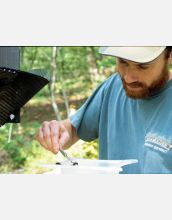Multimedia Gallery
Extracting a red oak borer beetle
Research specialist Vaughn Salisbury of the University of Arkansas extracts an adult red oak borer beetle from a tree for examination in the laboratory. Scientists estimate that the inch-long insect has damaged about $1 billion worth of commercial timber in Arkansas and Missouri over the past three years.
More about this Image
The red oak borer, an insect native to the Ozark National Forest in Arkansas and Missouri, lives most of its life cycle inside of oak trees. In recent years for unknown reasons, it has experienced a population explosion, causing the death of tens of thousands of trees in the Ozark forests. The insects have never before caused this kind of devastation and entomologists at the University of Arkansas are questioning what brought about the change.
Red oak borers have a two-year life cycle, most of which is spent inside a tree. Adult females lay their eggs under the lichens on the bark. The eggs hatch into larvae that bore into the bark and carve galleries in the phloem--a soft layer of woody tissue that lies beneath the bark. Later they migrate into the heart of the tree, chewing holes in the middle.
The trees can defend themselves against a few invaders--normally the average tree may have three or four adults emerge from its interior--but with the immense explosion in population, the attempt is futile. Researchers have seen as many as 700 to 800 emerging from one tree. The trees may look healthy for a while--sprouting green foliage--but by August, the top leaves turn brown, crumble and fall off, indicating the trees have become stressed.
Researchers are using modern technology to track progression of the problem. Satellite imagery can detect the presence and absence of chlorophyll in a given area, as well as give detailed data on the slope, aspect, vegetation type, soil type, and ridge top and valley locations in the landscape. This information, when combined with information on the age, density, diameter and vegetation composition of the forest, will be used to determine which forests have the heaviest infestations of the insect and see if it's possible to predict its spread. (Year of image: 2002)
Credit: ©2002 University Relations, University of Arkansas
Special Restrictions: This image contains a copyright. The image is not to be used in any for-profit manner, on packaging, as a product endorsement, etc. Permission is granted by the owner to use this image for personal or scientific illustration only.
Images and other media in the National Science Foundation Multimedia Gallery are available for use in print and electronic material by NSF employees, members of the media, university staff, teachers and the general public. All media in the gallery are intended for personal, educational and nonprofit/non-commercial use only.
Images credited to the National Science Foundation, a federal agency, are in the public domain. The images were created by employees of the United States Government as part of their official duties or prepared by contractors as "works for hire" for NSF. You may freely use NSF-credited images and, at your discretion, credit NSF with a "Courtesy: National Science Foundation" notation.
Additional information about general usage can be found in Conditions.
Also Available:
Download the high-resolution TIFF version of the image. (5 MB)
Use your mouse to right-click (Mac users may need to Ctrl-click) the link above and choose the option that will save the file or target to your computer.



